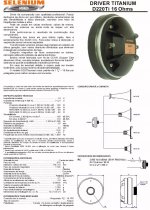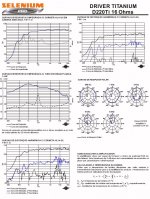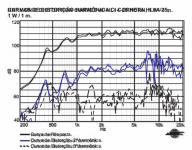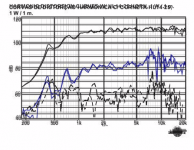Grabbing at straws I see. I wondered if it would come down to that. There is also packing density, I'm surprised that you did not bring that up. But these are all secondary effects to your point and my correction.
No again. You use your transducer and I will use the ones I buy or make. Mumpsimus.
If I personally took the time to measure an 8 and 16 driver and posted all the results what would that mean? At this point seemingly nothing as the data presented has already been rejected. More data would not help.
Last edited:
sumaudioguy. My apologizes if I snip
Maybe that was not clear enough- accepted apology. And an apology to you likewise.
sumaudioguy: Please take a chill pill. 😀 You seem to think that folks here are disregarding your experience and tests. That is not the case. We are quite interested what you have found.
The problem with a forum like this is that a lot of opinions get presented without anything to back them up. Opinions are fine, as long as they are stated as such. It's difficult in the clutter of 1000s of posts to know what is what and who is who. To know what is opinion and what has real research behind it. That is why presenting good measurements and tests goes such a long way here. Simply saying "I've done the tests" is good, but showing us the data is much, much better. That way we know that it is not just opinion and is based on careful study.
Unfortunately, all you have done is tell us about your lab testing...
Actually, he didn't do that until later on...if I'm not misreading this very confusing thread (to which I added confusion with my post which omitted a quotation I can no longer find, oddly).
Yes, a lot of people post opinions. If someone knows more factual evidence, it's best to say so in the first place. ("Based on my umpteen measurements of blah blah blah"...).
And now, to remedy my past offenses in that area, let me say that I HAVE MEASURED oh two dozen rectangular horns and their impedances were all spiky. I particularly remember an Electro-Voice combo, I think 1824M "mid" and T35 tweeter, as having very spiky impedances. My understanding is this is due generally to acoustic reflections/mismatches from the driver out to the horn throat. If you stuck some passive components on those it vaguely worked, but not too perfectly.
Now if the OP is using active crossovers, well then, all our nattering about the crossovers doesn't matter, the drivers won't see them. If using passive crossovers, then some parallel resistance would somewhat "de-spike" the combined impedance and the passive crossovers could work more ideally. But it's really best to measure actual impedances, and either do a lot of cut-and-try or do some initial simulations with LEAP or something.
In theory you might expect -3 dB less sensitivity with 16 ohms compared to 8 ohms and therefore less audible hiss...but due to factors mentioned already, a 16 ohm might not be much less sensitive than 8 ohms. You'd have to measure specific units-that's always the acid test.
Actually we could be better off nowadays if all our drivers were 16 or even maybe 32 ohms, since it's easier/cheaper to deliver voltage than current. But we are bound by past history, back to the days when that was not true. For instance, why are car speakers 4 ohms? Well, as told to me by colleagues who were there at the start, because at one point in time the Safe Operating Area of a transistor for car amps, when driven from a 12V battery, yielded the most power with a 4 ohm impedance. That's no longer true, but tradition is hard to buck...
Last edited:
I HAVE MEASURED oh two dozen rectangular horns and their impedances were all spiky....
This was discussed elsewhere as well.
A compression driver on a horn must have at least two peaks, this is the minimum. They will always be at the lower edge of the horns passband. More peaks are caused by reflections in the horn. A good waveguide does not exhibit anything other than the two lower peaks and the appearance of multiple peaks is a strong indication of a resonant sound quality.
The proof is in the pudding---
Have been waiting for these for a few days. Selenium was kind enough to send them over. Now I share them with all. Note the 8 ohm is in English and the 16 is in Portuguese but all parameters are in the same order on both spec sheets.
See the 16 ohm specs below and here is the 8 ohm specs from parts express:
http://www.parts-express.com/pdf/264-270s.pdf
I will admit that I am wrong if lower distortion, higher efficiency, lower Q, and flatter frequency response as found on the 16 ohm makes a driver worse. 🙄 Also note the same drive voltage produces the same output on the 16 ohm and 8 ohm version so the 16 ohm must be more efficient as I also claimed which via the formulation posted must also result in lower Q even though the mass is higher because of the winding length. BL squared always wins over Re contrary to gedlee. Further, please squint the at graphs in the usable pass band for impedance stability, distortion, and so on. Those are all equal and usually better. Please realize these graphs are taken at 1 watt 1 meter so the 16 ohm is about 3dB louder than the 8 ohm and horn distortion is therefore higher. In all cases the 16 ohm is flatter frequency response.
There is one thing which has always been apparent and is again shown by some studies with these and some other compression drivers- neodymium magnet structures always skimp on the magnet. There are several reasons for this but suffice to say neodymium is never worth the money...so far. These neo transducers seem to almost always lead to much less than ideal results than their ceramic magnet cousins and could lead to false conclusions about driver usefulness and behavior. Use the ceramic for more accurate understandings until the neo magnet type are of the same or better performance than there presently superior cousins.
I believe this discussion is over.
8 ohm and 16 ohm graphs and all from Selenium
Have been waiting for these for a few days. Selenium was kind enough to send them over. Now I share them with all. Note the 8 ohm is in English and the 16 is in Portuguese but all parameters are in the same order on both spec sheets.
See the 16 ohm specs below and here is the 8 ohm specs from parts express:
http://www.parts-express.com/pdf/264-270s.pdf
I will admit that I am wrong if lower distortion, higher efficiency, lower Q, and flatter frequency response as found on the 16 ohm makes a driver worse. 🙄 Also note the same drive voltage produces the same output on the 16 ohm and 8 ohm version so the 16 ohm must be more efficient as I also claimed which via the formulation posted must also result in lower Q even though the mass is higher because of the winding length. BL squared always wins over Re contrary to gedlee. Further, please squint the at graphs in the usable pass band for impedance stability, distortion, and so on. Those are all equal and usually better. Please realize these graphs are taken at 1 watt 1 meter so the 16 ohm is about 3dB louder than the 8 ohm and horn distortion is therefore higher. In all cases the 16 ohm is flatter frequency response.
There is one thing which has always been apparent and is again shown by some studies with these and some other compression drivers- neodymium magnet structures always skimp on the magnet. There are several reasons for this but suffice to say neodymium is never worth the money...so far. These neo transducers seem to almost always lead to much less than ideal results than their ceramic magnet cousins and could lead to false conclusions about driver usefulness and behavior. Use the ceramic for more accurate understandings until the neo magnet type are of the same or better performance than there presently superior cousins.
I believe this discussion is over.
8 ohm and 16 ohm graphs and all from Selenium
Attachments
Sumaudioguy, do you have a speaker deisgn? some build thread? or something to gives me the evidence of "and then there are a very few like myself that actually know what they speak of or keep their mouths shut."
For someone that keeps their mouth shut you sure do have some long winded posts?
Post who you work for if you are in the business. Geddes hides nothing, he is simply one of those brutally honest guys with a TON of credentials. Lets see your crendentials.
You have yet to post ONE measurement of your own (although you rave about your measuring lab). Posting specs from company brochures is lame, IMO. You need to start producing meaurements to back up your opinion. I would like to see your measurements proving your 16 ohm vs 8 ohm theory and I would LOVE to see your measurements proving your theory about horn honk reduced by using felt between the throat and the horn that covers 1/2 the area of the throat.
Your tag line "People do not care about facts- people only wish to feel good about what they believe. " Is truely funny because so far that is you so far.
For someone that keeps their mouth shut you sure do have some long winded posts?
Post who you work for if you are in the business. Geddes hides nothing, he is simply one of those brutally honest guys with a TON of credentials. Lets see your crendentials.
You have yet to post ONE measurement of your own (although you rave about your measuring lab). Posting specs from company brochures is lame, IMO. You need to start producing meaurements to back up your opinion. I would like to see your measurements proving your 16 ohm vs 8 ohm theory and I would LOVE to see your measurements proving your theory about horn honk reduced by using felt between the throat and the horn that covers 1/2 the area of the throat.
Your tag line "People do not care about facts- people only wish to feel good about what they believe. " Is truely funny because so far that is you so far.
Last edited:
sumaudioguy, you sound scaringly alike mr Geddes, at times....but please leave out the personal and insulting stuff 

OK, thanks for the plots and for digging up the 16 ohm Selenium plot.
But I have to admit, I don't see that much difference. So I did an overlay of the 2 1W/1M plots. Can you tell which driver is which?
Yes,the one on top is the 16 ohm in the frequency response and the ones on the bottom in distortion are the 16 ohm. Okay, I admit the differences are not the difference between night time and day time and never meant to claim otherwise. It is just the 16 ohm is better than the 8 ohm if all things are held otherwise equal now with a new exception- that the magnet structure is sufficient to support the higher BL of the 16 ohm. Also recall the 16 ohm is 3 dB more efficient with the same drive voltage so the distortion curves for the 16 ohm are at a higher SPL than the 8 ohm. That says a lot right there. Note the same power drive but the same voltage drive for sensitivity.
If you were looking for a night day difference I cannot say that ever happens. If you are looking for a small incremental improvement then these data should be sufficient to show that.
I post info from 3rd parties because that is unbiased and have done so now with 2 different manufacturers to support these statements. If I post my own results then the door swings wide open for a flood of "you do not know how to measure" post. Not interested.
Hi,
Give the Selenium sensitivity spec sheet there is not same voltage, 8Ohm vs 16Ohm, it is the same power.
So sensitivity (and force) stays the same from a power standpoint.
Give the Selenium sensitivity spec sheet there is not same voltage, 8Ohm vs 16Ohm, it is the same power.
So sensitivity (and force) stays the same from a power standpoint.
Hi,
Give the Selenium sensitivity spec sheet there is not same voltage, 8Ohm vs 16Ohm, it is the same power.
So sensitivity (and force) stays the same from a power standpoint.
Yes, exactly as predicted by the theory.
1W/1m is usually 1W into the Rvc or rated impedance of the driver
it is constant voltage so that the curve represents real world use.
Those curves show that the real efficiency stays the same as the theory
predicts.
I'm glad that others caught this. To make the point more clearly, the voltage is not the same, its much higher for the 16 Ohm unit.
On the data sheet there is a sensitivity spec which states "2.83 volts at 1 meter." Last time I checked 2.83 volts is not the same power when applied to an 8 ohm and 16 ohm transducer. Yet the acoustic output is the same acoustic power for 8 and 16 ohm version. This means the 16 ohm is more efficient because less power is applied.
Half current and double voltage, same power, same wattage, yes... no ?
But I suppose that voltage is more "efficient" than current, at least with regards to tweeters
But I suppose that voltage is more "efficient" than current, at least with regards to tweeters
P=U^2/R
P=I^2*R
I think one must take into account that the data sheet form probably is written with solely 8Ohm drivers in mind. However, the page with response graphs clearly states 1W/1M.
P=I^2*R
I think one must take into account that the data sheet form probably is written with solely 8Ohm drivers in mind. However, the page with response graphs clearly states 1W/1M.
Mistakes are made on data sheets, however, this fellow wants us to believe that Beranek, Thiele, Small, Leach, etc. etc. are all wrong - I don't think so!
I do admit that the datasheets are confusing because they both say 109dB @ 2.83 volts. That's 1W for the 8 ohm, 1/2 watt for the 16. But the graphs both say 1W/1M. So which is it?
I did a graph overlay again, this time aligning the SPL trace - as one would do in a complete system. Now we don't see the 1 or 2dB difference and I would say that FR and distortion are a wash. The 16 ohm "may" have a better top end.
So I'll go back to my statement early in this thread - In practical use it will not make a difference, as long as the crossover is adjusted to suit.
So until I see some good measurements of other drivers in 8 and 16 ohm versions, I'll remain unconvinced. But on a fun note, I did order new Altec 288 'frams the other day. I had a choice of 8 or 16 ohm. I chose 16. 😉
I did a graph overlay again, this time aligning the SPL trace - as one would do in a complete system. Now we don't see the 1 or 2dB difference and I would say that FR and distortion are a wash. The 16 ohm "may" have a better top end.
So I'll go back to my statement early in this thread - In practical use it will not make a difference, as long as the crossover is adjusted to suit.
So until I see some good measurements of other drivers in 8 and 16 ohm versions, I'll remain unconvinced. But on a fun note, I did order new Altec 288 'frams the other day. I had a choice of 8 or 16 ohm. I chose 16. 😉
Attachments
Is there something new on the topic? Might I ask Pano if he formed any new oppinion based on Altec 288 16 ohm version? Thank you.
I did contact Selenium and with much help and translation was informed all measurements are taken at 2.83 volts.
No one I ever heard of other than many on this forum suggest 4, 8, and 16 ohm drivers should be the same sensitivity concerning power input. Literally everyone I know professionally says all other things being normal, 16 ohm driver will be more efficient than an 8 ohm driver which is more efficient than a 4 ohm driver. Same is true for woofers which can easily be determined from the Eminence web site like here:
Speaker Detail | Eminence Speaker
Speaker Detail | Eminence Speaker
or,
Speaker Detail | Eminence Speaker
Speaker Detail | Eminence Speaker
In spite of the higher supposed mass of the more efficient drivers. Some manufacturers do adjust parameters so drivers are the same efficiency in different impedance values. Many things can affect the actual result if small changes are made in other aspects of the completed driver. In the end, 4 ohms just makes more heat and less sound as a general rule.
One more thing, higher impedance drivers usually means a lower Q but not always.
Ready for more flames from those who live in a magic world where these factors simply wash out.
Lots of luck learning.........
No one I ever heard of other than many on this forum suggest 4, 8, and 16 ohm drivers should be the same sensitivity concerning power input. Literally everyone I know professionally says all other things being normal, 16 ohm driver will be more efficient than an 8 ohm driver which is more efficient than a 4 ohm driver. Same is true for woofers which can easily be determined from the Eminence web site like here:
Speaker Detail | Eminence Speaker
Speaker Detail | Eminence Speaker
or,
Speaker Detail | Eminence Speaker
Speaker Detail | Eminence Speaker
In spite of the higher supposed mass of the more efficient drivers. Some manufacturers do adjust parameters so drivers are the same efficiency in different impedance values. Many things can affect the actual result if small changes are made in other aspects of the completed driver. In the end, 4 ohms just makes more heat and less sound as a general rule.
One more thing, higher impedance drivers usually means a lower Q but not always.
Ready for more flames from those who live in a magic world where these factors simply wash out.
Lots of luck learning.........
- Status
- Not open for further replies.
- Home
- Loudspeakers
- Multi-Way
- 1" Compression driver 8 ohm vs 16ohm



